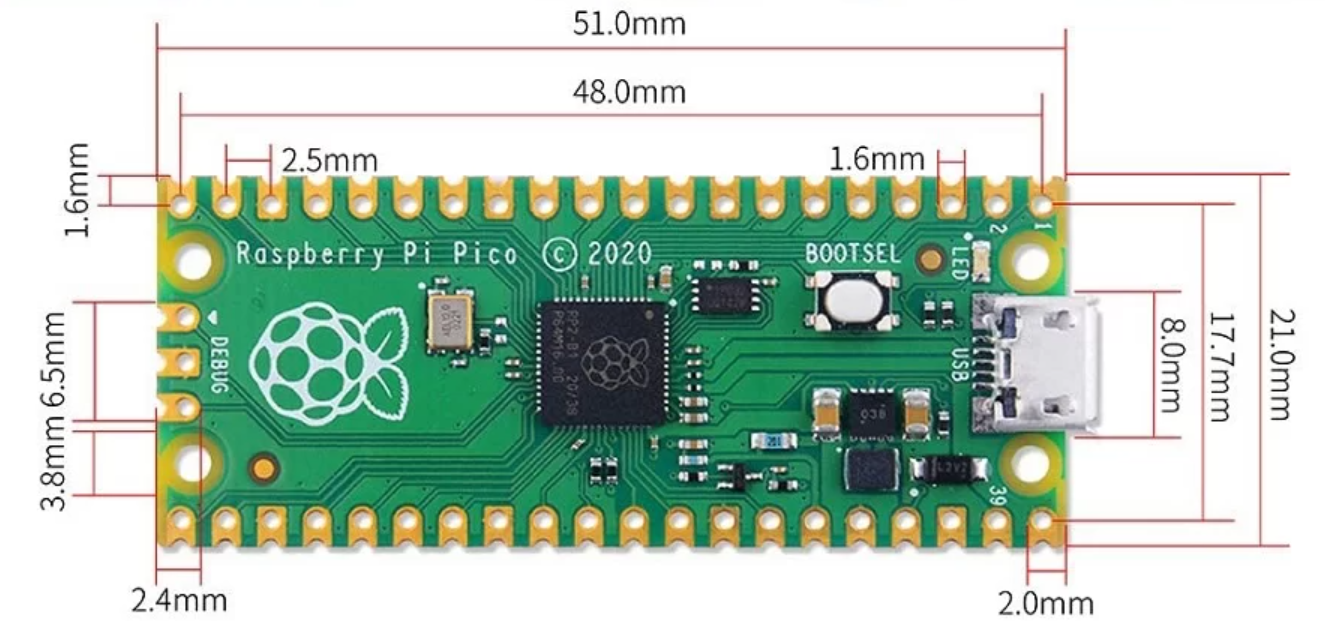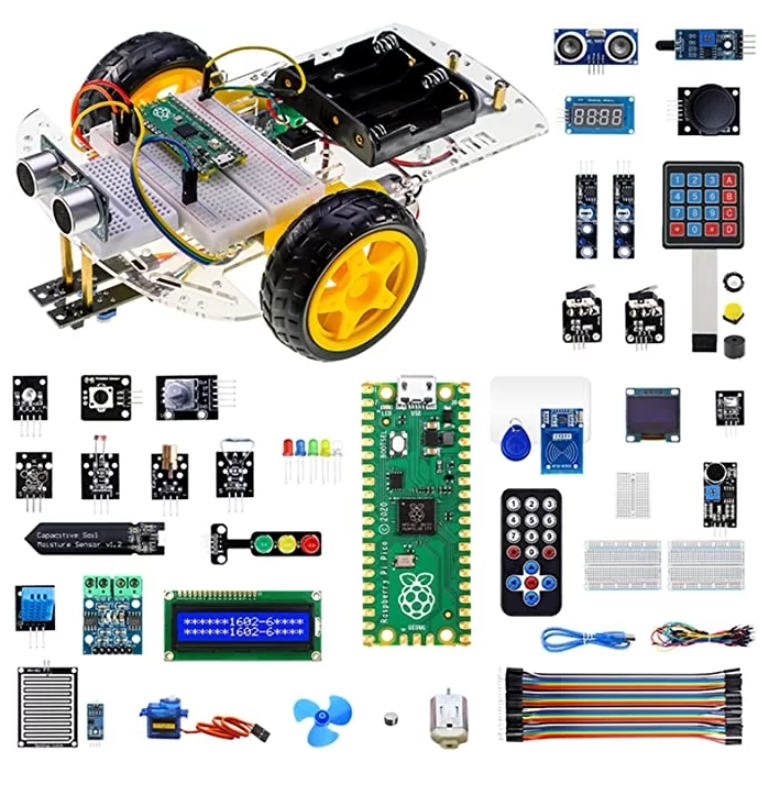The Top 5 RP2040 Boards in 2023
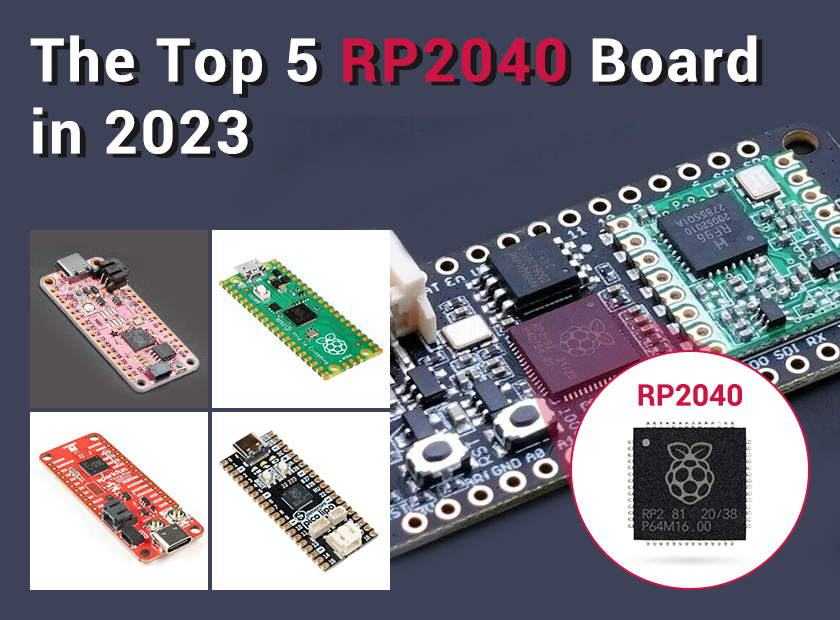
2023 Top 5 RP2040 Boards: Unleashing the best of Raspberry Pi's MCU
Prologue
RP2040, the Raspberry Pi Foundation's first in-house chip, was announced in January 2021. The Raspberry Pi Pico, the first development board powered by RP2040, is used in countless projects today.
Recent introductions such as the Raspberry Pi Pico W, which includes wireless capabilities, have further broadened Pico's appeal. But Pico isn't suitable for every application, and it's not the only RP2040 board out there.
To help you understand more about the great capabilities of the Raspberry Pi RP2040 MCU, we have done some research on what projects are possible based on the RP2040 board, and in this blog, we will cover the 5 RP2040 board projects to help you understand them better.
What is Raspberry Pi RP2040?
There is no way to adequately state just how much of an impact this tiny piece of silicon has had on the embedded electronics and hobby markets. In addition, it has the extensive processing and I/O needed to run most typical microcontroller applications. It's easy to use, and it's supported by the legendary Raspberry Pi community.
With a dual-core Cortex-M0+ processor (the most energy-efficient Arm processor), 264 kB of RAM, and support for I/O options such as programmable IO and 4 ADCs, the hardware specs are impressive. Its boot loader loads firmware from external flash memory or USB (up to 16 MB) instead of permanent onboard memory.
MicroPython is the primary programming language of the RP2040, however, C++ and Adafruit CircuitPython are also supported, all accompanied by a range of new and ported functional libraries.
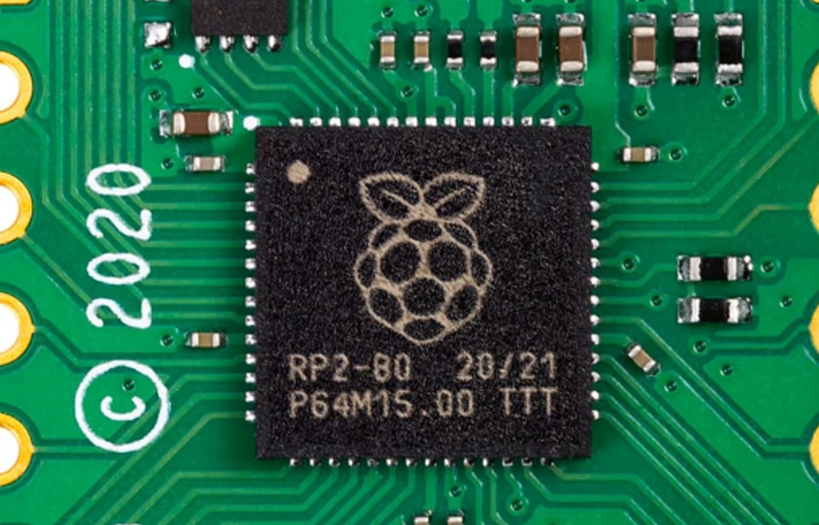
RP2040 datasheet
Why is this chip called RP2040?
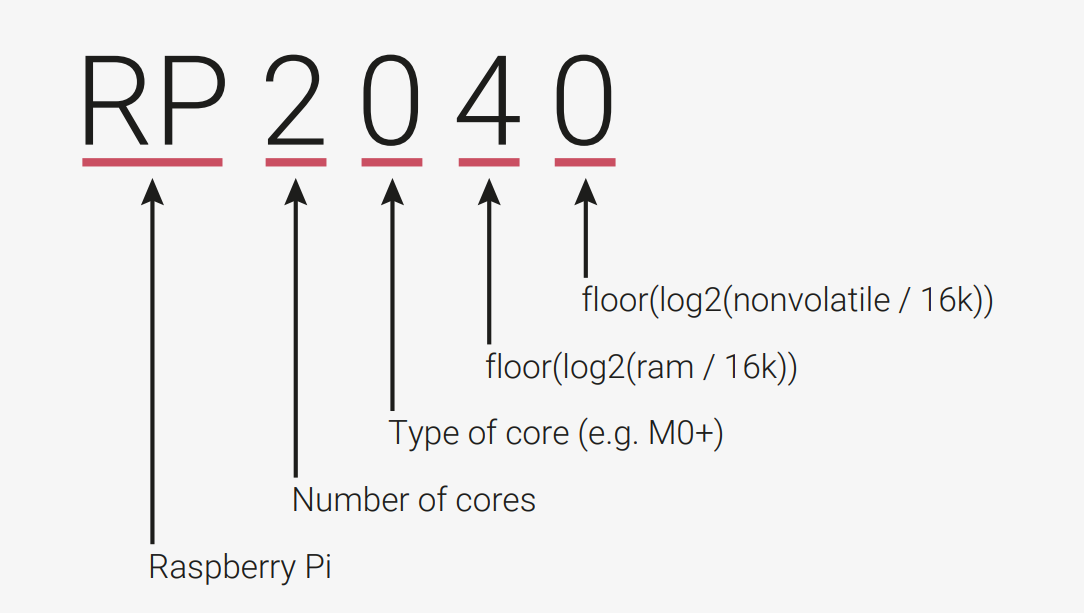
RP2040 datasheet-chip info
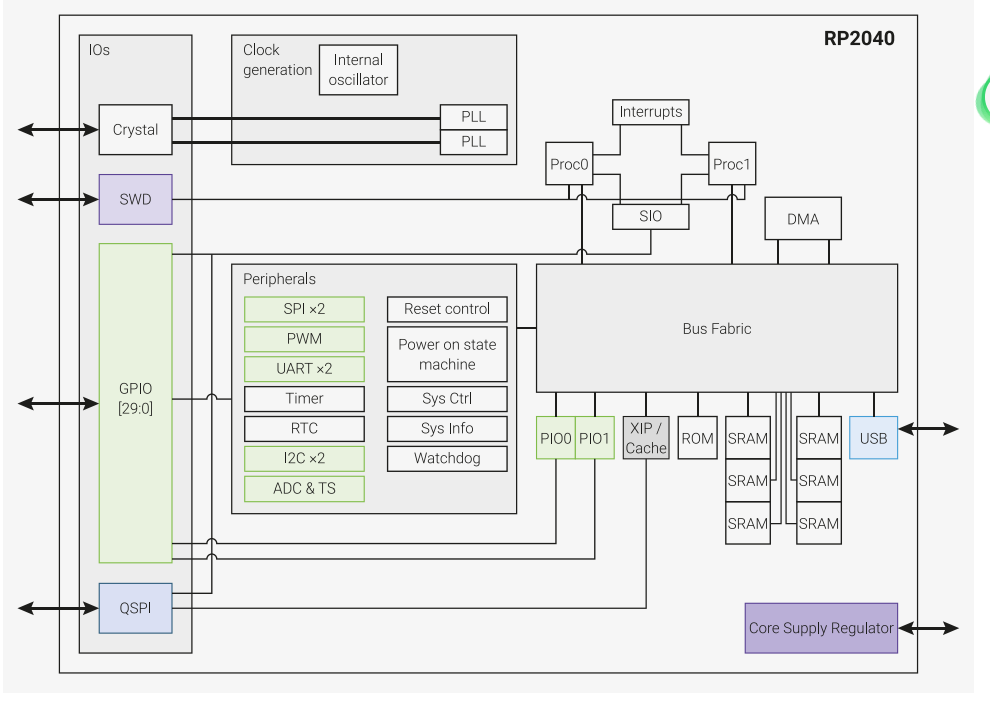
The RP2040 has two M0+ processor cores, DMA, internal memory, and peripheral blocks connected via the AHB/APB bus fabric. The figure above provides an overview of the RP2040 architecture, which allows code to be executed directly from external memory using dedicated SPI, DSPI, or QSPI interfaces. In addition, a small cache improves performance for typical applications. Debug functionality is available through the SWD interface, while internal SRAM is organized into banks that can contain code or data. SRAM is accessed via dedicated AHB bus fabric connections that allow bus masters to access separate bus slaves without stalling. DMA bus masters are also available to offload repetitive data transfer tasks from the processors. GPIO pins can be driven directly or by various dedicated logic functions. The RP2040 also features dedicated hardware for fixed functions such as SPI, I2C, and UART, as well as flexibly configurable PIO controllers that can provide a wide range of IO functions.
A USB controller with embedded PHY is included in the RP2040, enabling software-controlled FS/LS host or device connectivity. Four ADC inputs are shared with GPIO pins, and two PLLs provide a fixed 48MHz clock for USB or ADC, as well as a flexible system clock of up to 133MHz. Finally, an internal voltage regulator is included to supply the core voltage, so the end product only needs to supply the IO voltage.
RP2040 datasheet-pin locations
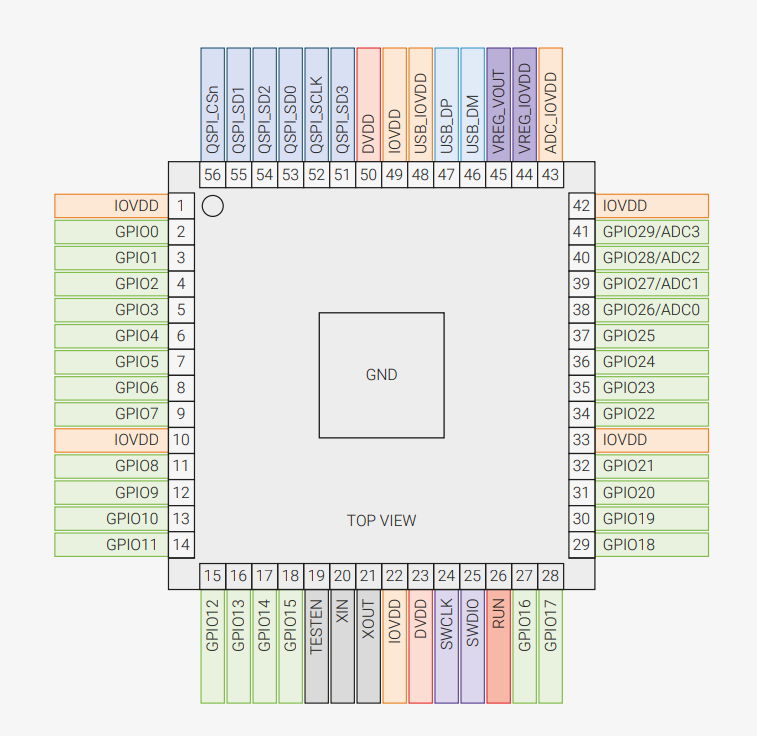
Raspberry Pi Pico
With its first release based on the RP2040, the Raspberry Pi Pico has already gained widespread recognition and is referred to simply as “the Pico”. The design of Raspberry Pi was designed to hit the magical $5 price point, so it made some classic engineering compromises (as outlined below) but, for most, these were more than offset by the outstanding basic capabilities, ease of use, and fantastic levels of support that go along with all Raspberry Pi products.
During the first two months after its launch, over 1 million units were ordered, and three new variants have been launched, including the Raspberry Pi Pico W with Wi-Fi.
Raspberry Pi Pico is such a powerful MCU, there are many advanced product kits based on it for makers to upgrade their programs or practice STEAM education for kids, for example, Elecrow provides Raspberry Pi Pico Advanced Kit with 32 modules and 32 projects lessons, which can make the STEAM education work well without any problems.
Features
Pros:
The Raspberry Pi Pico is inexpensive (only $5), easy to use, well supported, and has great features that make it stand out from many other MCUs and is the baseline for all other RP2040-based alternatives.
Cons:
The Raspberry Pi Pico device is highly regarded, but it has some limitations that are worth considering before exploring alternatives. These include the lack of a reset button, insufficient onboard flash memory, physical size and form factor issues, and lack of support for certain features such as Bluetooth and Ethernet. In addition, the Pico has limitations when it comes to powering higher-power devices and has no direct audio support or built-in LiPo battery support. Although these limitations can be overcome with peripheral circuitry or dedicated board designs, these solutions may compromise the low cost and simplicity of the Pico, which are key features of the device.
SparkFun’s Thing Plus – RP2040
SparkFun has produced outstanding versions of its main development boards based on the RP2040, including the compact Pro Micro size. The Thing Plus - RP2040 stands out as an especially capable example.
With Feather-compatible pinouts and 16MB flash memory, it's slightly larger than a Pico and comes with Feather-compatible pinouts, a JST battery connector (with charging circuit and fuel gauge sensor), an LED onboard that looks like NeoPixel, a reset button, and their signature Qwic connector. Additionally, it has an underside MicroSD card slot (that is narrow enough to keep breadboard connectivity), which is an added feature that many projects might find useful.
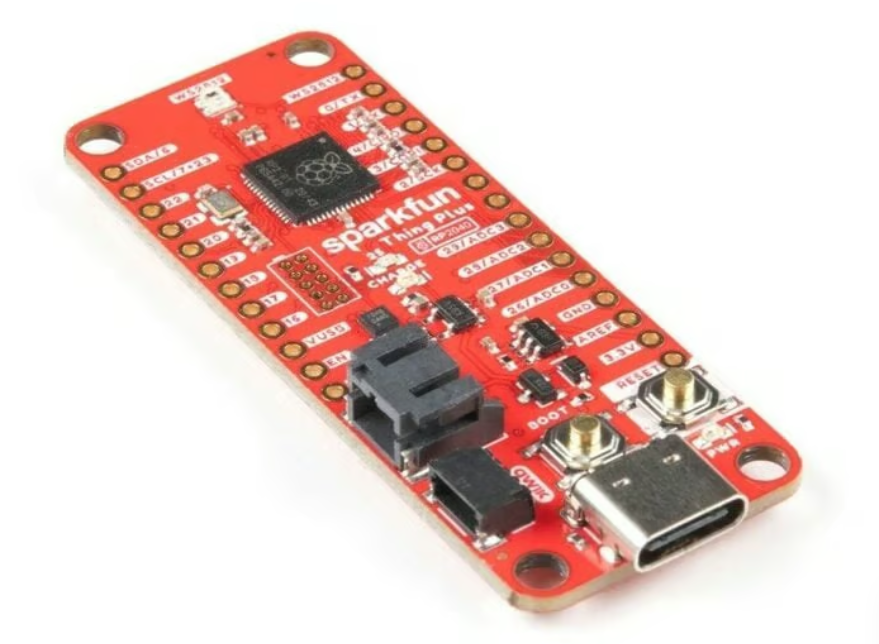
Features:
The SparkFun Maker Board features an SD card reader, battery charging capabilities, and a powerful management system. It retails for about $20.
Adafruit Feather RP2040
Adafruit offers RP2040-based boards in all of its popular formats (e.g. the ItsyBitsy), among which the Feather RP2040 stands out. Although it comes at a higher price point, it is arguably one of the best RP2040-based boards for general purposes.
Adafruit feather rp2040 is roughly of the same size as a Pico, and it's compatible with many FeatherWings, an extensive range of add-on boards. If that's not enough to convince you, it's also got some pretty cool features.
Connecting sensors is made easy with its Stemma QT connector while charging LiPo batteries and connecting flash memory are also available. The device has been built with an actual reset button, has 8 MB of onboard flash memory, and has four ADC ports.
Not only does it come with a red general-purpose LED, but this board also boasts an onboard programmable NeoPixel. In essence, it effectively resolves many of the perceived drawbacks of the Pico. Furthermore, Adafruit provides comprehensive support for this board and even offers a pink variant(pink adafruit feather rp2040) for those interested. Overall, it's hard to find any downsides to this impressive offering.
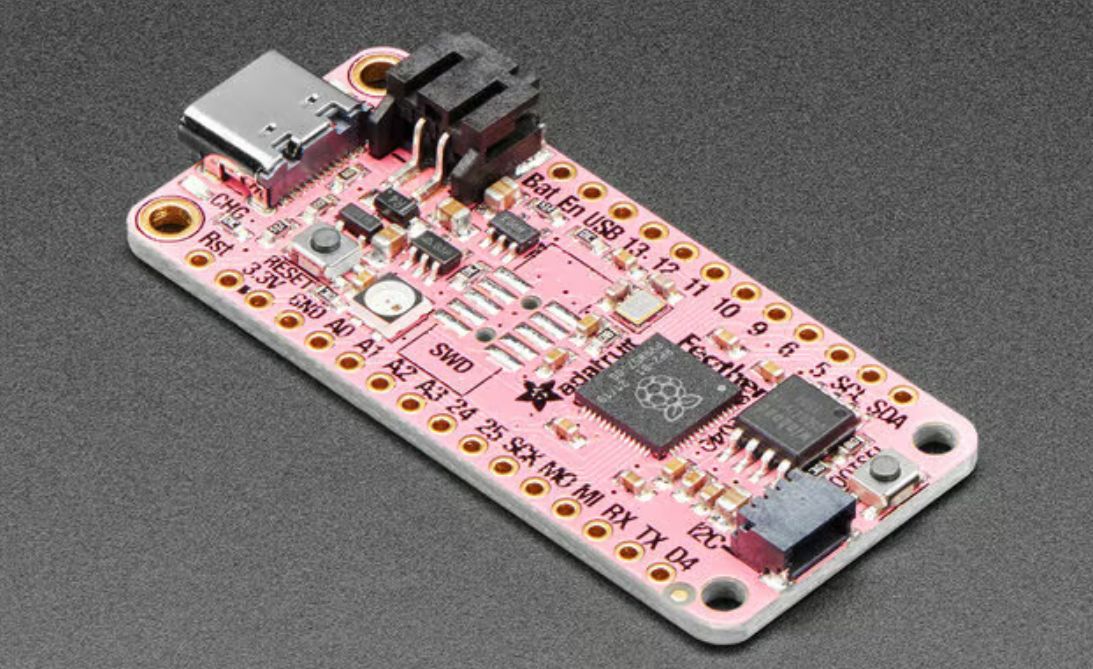
Features:
Pros:
+Compact, well-designed form factor
+STEMMA QT user-friendly interface
+FeatherWing add-ons expand functionality
+Onboard battery charging and connection capability
+Pin labelling on both sides of the board
Cons:
-Lacks pull-up resistors on I2C pins
-No built-in battery monitoring feature
Pimoroni’s Pico Lipo
Pimoroni's Pico Lipo is another excellent all-around board that shares the same form factor and GPIO pinout as the Pico, making it a suitable drop-in replacement in most cases. This feature allows it to work quite well with a wide range of Pico peripherals, although there are a few small components on the bottom of the board that are generally not problematic.
Similar to the Feather RP2040, this board features LiPo battery connection and charging, as well as battery monitoring, additional memory options (4 or 16 MB), a reset button, a Stemma QT connector, and USB-C. It receives consistently positive user reviews and is backed by Pimoroni's exceptional customer service.
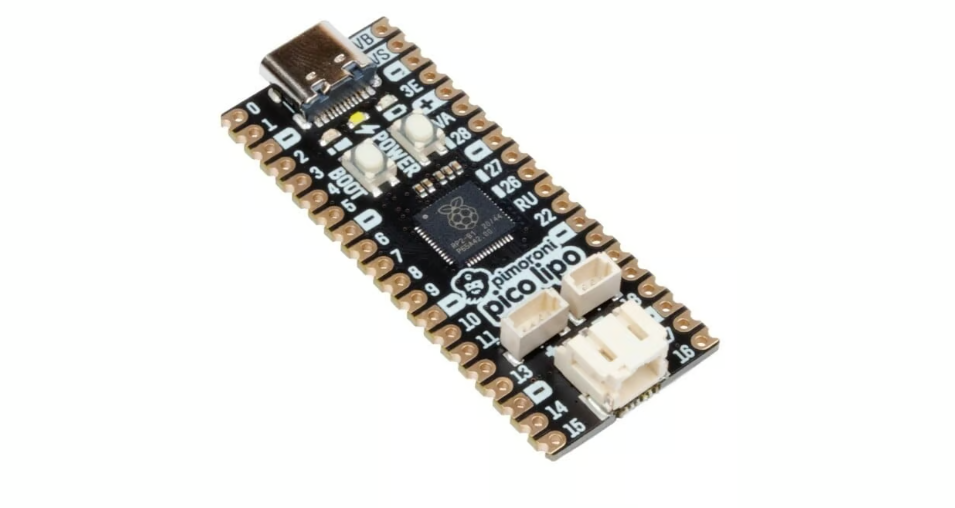
Features:
Pros:
+Retains Pico's identical pinout
+Capable of battery charging
+Includes a Stemma QT/Qwiic connector
+Offers a generous amount of flash memory and memory expansion
+Equipped with USB-C support
Cons:
+Comes at a higher cost than the standard Pico
Challenger RP2040 LoRa
While Wi-Fi and Bluetooth are commonly associated with wireless connectivity, the low-power LoRa protocol is rapidly gaining popularity, particularly for remote IoT applications. ILabs offers a range of Challenger development boards featuring an RP2040 core and supporting various protocols. These include the Challenger RP2040 LoRa board, which is available in 868MHz and 915MHz versions to meet regional requirements.
This feather-sized board includes a USB-C connector, reset button, and LiPo battery charging capabilities. It uses SPI to communicate with the on-board LoRa module, which is dedicated to a few GPIO pins. Other than these dedicated pins, all of the RP2040's functionality remains fully accessible.
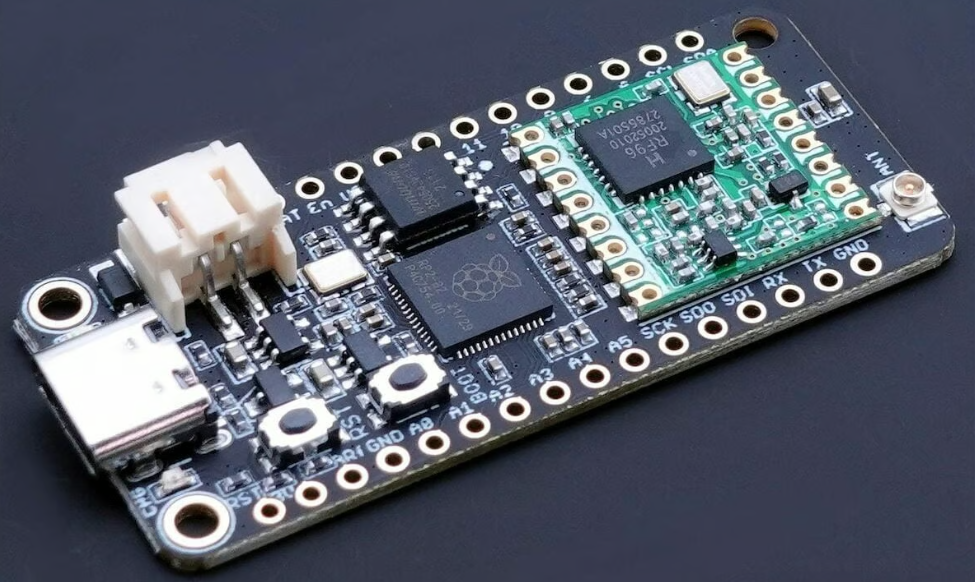
Features
ILabs offers a unique development board with built-in LoRa capabilities, making it a rare find on the market. This outstanding feature is available on their Challenger RP2040 LoRa board, priced at approximately $25.
Final Words
The RP2040 is an impressive microcontroller that has inspired the development of a wide range of innovative boards and projects. From the Adafruit Feather RP2040 to the ILabs Challenger RP2040 LoRa board, the options available to developers are vast and exciting.
Elecrow is a notable player in the RP2040 board market and offers an impressive range of Raspberry Pico products including the Raspberry Pi Pico Development Board, the RP-2040 Core Board, and the Raspberry Pi Pico GPIO Expansion Board. These boards are built to high standards and are designed to be both reliable and functional at an affordable price. If you are interested in the RP2040 MCU-based boards, do not hesitate to order them from Elecrow. If you are interested in developing your own products based on the powerful and compact RP2040 MCU, you can even join Elecrow's Partner Seller Program to mass produce your projects and reap the benefits!

